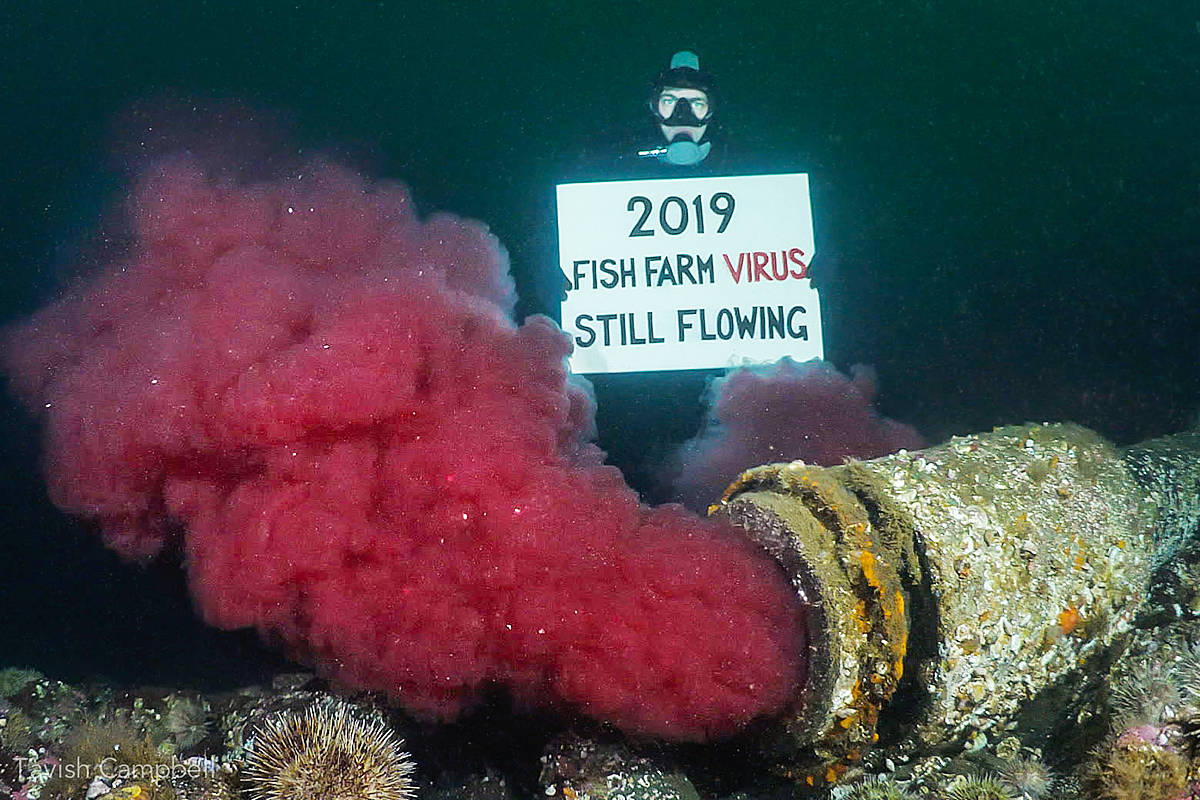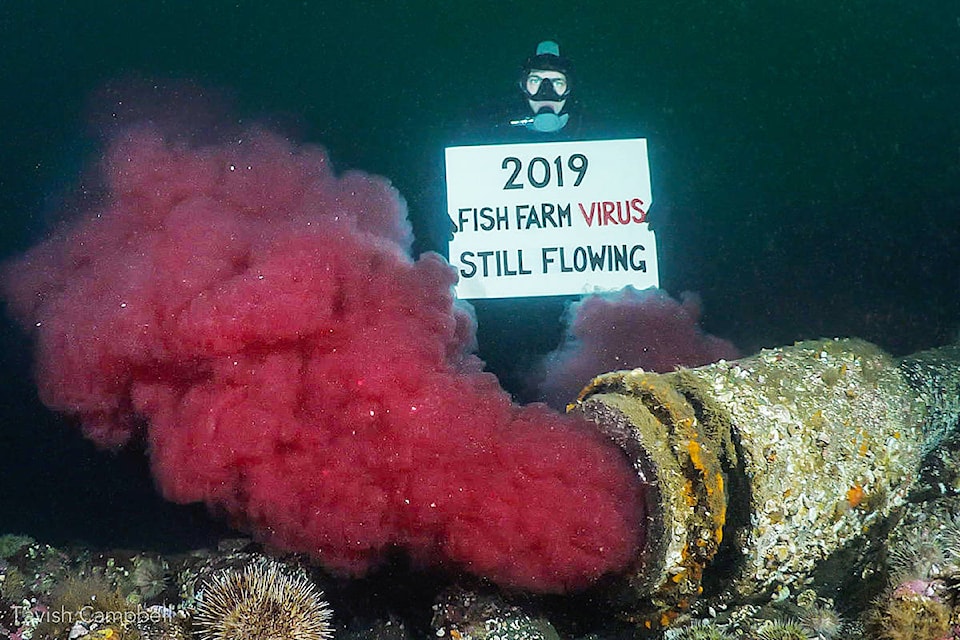Brown’s Bay Packing Co. says its fish processing operation has “no measurable impact on the receiving environment” despite a claim that nothing has changed two years after alarm bells were raised about virus-infected “blood water” being discharged.
“It certainly isn’t sterile or neutralized, there’s still the (piscine orthoreovirus – PRV) virus in the blood,” Tavish Campbell says.
The Quadra Island photographer, diver and activist gained notoriety in 2017 when he released a video entitled “Blood Water: B.C.’s Dirty Salmon Farming Secret” that included a dramatic underwater image of blood-red water being discharged from a pipe in Brown’s Bay north of Campbell River coming from the Brown’s Bay Packing Co. plant. The film also included Lions Gate Fisheries’ plant in Tofino.
RELATED: ‘Blood water’ video shows bloody effluent emitting from farmed salmon processing plant
The video and testing of the effluent which showed it contained PRV resulted in a provincial Ministry of Environment review in 2018 that determined most fish processing plants that discharge waste into B.C. waters violate provincial regulations and tougher regulations are needed to protect wild salmon from disease-causing pathogens.
RELATED: Report reveals widespread violations by fish processing facilities
Campbell went back to Brown’s Bay at the end of October and November of this year, shot more video and pictures of the same effluent pipe and collected more samples. He sent those samples to a lab at the Atlantic Veterinary College in Charlottetown, P.E.I. and he said they came back positive for PRV. He released a new video and a statement Dec. 3 entitled “Two Years Later: Virus-Infected Fish Farm Blood Still Flowing.”
Infected Blood and Collapsing Wild Sockeye from Tavish Campbell on Vimeo.
Genetic sequencing of this virus reveals that it came from the Atlantic Ocean and was most likely imported via salmon eggs by the fish farm industry, Campbell says in his Dec. 3 statement.
In a statement published on Brown’s Bay Packing Ltd.’s website, Managing Partner Dave Stover responded to the new video and testing of the company’s outfall.
“While we haven’t seen the video or the laboratory testing results, including sampling methodology, it’s timely to update the public on our progress with wastewater treatment since 2017,” Stover says. “The alleged video follows the one from 2017 showing red effluent from our pipe. The reaction to the original 2017 video understandably prompted concern from government, First Nations, our neighbours, our community, the industry, and our employees. We are held to the highest standards in Canada by the Federal and Provincial Governments and third-party regulators such ASC. We care deeply about our relationships and the environment, and since 1989 we have a proven track record to be innovative, collaborative, and a good community corporate citizen.”
Stover says in January 2018, B.C.’s Ministry of Environment enacted a process to review waste water treatment permits in the fish processing sector, as most permits on the coast were outdated. The process also included a review of the best available technology to treat fish processing effluent to ensure that any effluent discharge would have minimal impact on the receiving marine environment.
“The permit review process lasted approximately 16 months. Upon its conclusion, a completely revamped wastewater treatment permit was issued to us by the Ministry of Environment. Our new permit contains the strictest water quality testing parameters and ongoing monitoring requirements for fish processing effluent on the coast of B.C. We fully support the strict and responsible standards,” Stover says.
The company has invested $1.5 million and received government grant funding to improve on the world’s leading technology in wastewater treatment.
“We are nearing the end of the commissioning phase and our ongoing testing and monitoring continues to conclude that despite over 30 years in operation, we have no measurable impact on the receiving environment. Once complete, we will provide links to our sampling program and our monitoring reports,” Stover says. “As someone who was raised in the Campbell River area, I have an unwavering commitment to our land and sea. I believe that it’s my responsibility to ensure that my business activities operate in a sustainable and environmentally friendly way.
“At Brown’s Bay we remain committed to ensuring that our operation cares for the environment, our employees, our community, and our partners.”
As in 2017, Campbell says his intention is not to demonize Brown’s Bay Packing.
“Obviously, they are not doing anything illegal,” he says. “This comes down to the Department of Fisheries and Oceans and their failure to recognize this virus is a threat to wild salmon.”
The issue is infected farm fish which plants like Brown’s Bay process. A 2018 paper published by the Strategic Salmon Health Initiative shows that PRV does in fact cause harm to Pacific salmon.
“DFO’s (Fisheries and Oceans Canada) science reports that PRV is harming Pacific salmon by rupturing their red blood cells, leading to jaundice yellowing and organ failure. With over 80 per cent of the farmed salmon in B.C. infected with PRV, open netpen fish farms and processing plants continue to release this virus into wild salmon habitat in blatant disregard for the precautionary principle,” Campbell says. “Under Section 56(b) of the Fisheries (General) Regulations, transferring farm salmon into the ocean from hatcheries infected with a disease agent is prohibited. DFO continues to approve this high-risk behavior by allowing infected farmed salmon to be grown in wild salmon migration routes on the B.C. coast.”
Campbell says he also re-tested effluent from the Lions Gate Fisheries plant in Tofino in November. Samples from the Tofino testing are currently at the Atlantic Veterinary College and he will release those results when they come back to him.
@AlstrT
editor@campbellrivermirror.com
Like us on Facebook and follow us on Twitter

